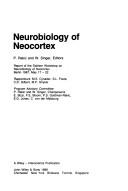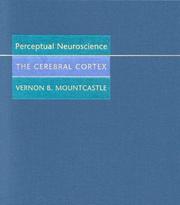| Listing 1 - 6 of 6 |
Sort by
|
Book
ISBN: 9780262356145 0262356147 9780262043243 0262043246 Year: 2019 Publisher: Cambridge : MIT Press,
Abstract | Keywords | Export | Availability | Bookmark
 Loading...
Loading...Choose an application
- Reference Manager
- EndNote
- RefWorks (Direct export to RefWorks)
Experts review the latest research on the neocortex and consider potential directions for future research.Over the past decade, technological advances have dramatically increased information on the structural and functional organization of the brain, especially the cerebral cortex. This explosion of data has radically expanded our ability to characterize neural circuits and intervene at increasingly higher resolutions, but it is unclear how this has informed our understanding of underlying mechanisms and processes.In search of a conceptual framework to guide future research, leading researchers address in this volume the evolution and ontogenetic development of cortical structures, the cortical connectome, and functional properties of neuronal circuits and populations. They explore what constitutes uniquely human mental capacities and whether neural solutions and computations can be shared across species or repurposed for potentially uniquely human capacities.Contributors Danielle S. Bassett, Randy M. Bruno, Elizabeth A. Buffalo, Michael E. Coulter, Hermann Cuntz, Stanislas Dehaene, James J. DiCarlo, Pascal Fries, Karl J. Friston, Asif A. Ghazanfar, Anne-Lise Giraud, Joshua I. Gold, Scott T. Grafton, Jennifer M. Groh, Elizabeth A. Grove, Saskia Haegens, Kenneth D. Harris, Kristen M. Harris, Nicholas G. Hatsopoulos, Tarik F. Haydar, Takao K. Hensch, Wieland B. Huttner, Matthias Kaschube, Gilles Laurent, David A. Leopold, Johannes Leugering, Belen Lorente-Galdos, Jason N. MacLean, David A. McCormick, Lucia Melloni, Anish Mitra, Zoltn Molnr, Sydney K. Muchnik, Pascal Nieters, Marcel Oberlaender, Bijan Pesaran, Christopher I. Petkov, Gordon Pipa, David Poeppel, Marcus E. Raichle, Pasko Rakic, John H. Reynolds, Ryan V. Raut, John L. Rubenstein, Andrew B. Schwartz, Terrence J. Sejnowski, Nenad Sestan, Debra L. Silver, Wolf Singer, Peter L. Strick, Michael P. Stryker, Mriganka Sur, Mary Elizabeth Sutherland, Maria Antonietta Tosches, William A. Tyler, Martin Vinck, Christopher A. Walsh, Perry Zurn
Neocortex. --- NEUROSCIENCE/General --- Homogenetic cortex --- Isocortex --- Laminated cortex --- Neopallium --- Nonolfactory cortex --- Cerebral cortex
Book
Abstract | Keywords | Export | Availability | Bookmark
 Loading...
Loading...Choose an application
- Reference Manager
- EndNote
- RefWorks (Direct export to RefWorks)
This research topic was suggested by Robert Sachdev to bring together a series of articles dealing with the laminar organization of the neocortex. By convention, there are six cortical layers but this number may vary throughout the cerebral cortex of a given species or between species: many regions lack one or more layers, whereas in other regions there are more than six layers. The laminar location of cortical neurons —their cell bodies— is determined during development. However, neurons are more than their cell bodies; they also have dendrites that may span within a given layer (intralaminar neurons) or across a variety of layers (translaminar neurons). For example, layer V pyramidal neurons have dendrites that span the entire cortical depth, whereas layer III pyramidal neurons have dendrites that span across layers I to IV. Some GABAergic interneurons have dendrites located within a cortical layer (e.g., neurogliaform cells), whereas the dendrites of other interneurons span several layers (e.g., bitufted cells). For neurons having dendrites that cross laminar boundaries, one might ask, why segregate their cell bodies so carefully into lamina? Among many other obvious questions: What is the evidence for or against integration of information across laminae for neurons whose dendrites span several layers? A traditional view is that activity flows through cortical layers in a feed-forward manner, going from layer IV, to layers II and III and onwards. Another view is that cortical layers can have distinct inputs that activate them, triggering spikes. Can processing sequences be state dependent? Furthermore, different cortical layers have distinct transcriptomic profiles, neurochemical attributes, connectivity patterns, number and types of synapses and many other structural attributes. Thus, based on anatomy, or physiology or imaging: What is the function of each cortical layer? What do the different layers do?
periallocortex --- receptors --- cell types --- GABAergic connectivity --- isocortex --- insular cortex --- olfactory --- Reeler --- Pyramidal neurons --- Cortical evolution
Book
Abstract | Keywords | Export | Availability | Bookmark
 Loading...
Loading...Choose an application
- Reference Manager
- EndNote
- RefWorks (Direct export to RefWorks)
This research topic was suggested by Robert Sachdev to bring together a series of articles dealing with the laminar organization of the neocortex. By convention, there are six cortical layers but this number may vary throughout the cerebral cortex of a given species or between species: many regions lack one or more layers, whereas in other regions there are more than six layers. The laminar location of cortical neurons —their cell bodies— is determined during development. However, neurons are more than their cell bodies; they also have dendrites that may span within a given layer (intralaminar neurons) or across a variety of layers (translaminar neurons). For example, layer V pyramidal neurons have dendrites that span the entire cortical depth, whereas layer III pyramidal neurons have dendrites that span across layers I to IV. Some GABAergic interneurons have dendrites located within a cortical layer (e.g., neurogliaform cells), whereas the dendrites of other interneurons span several layers (e.g., bitufted cells). For neurons having dendrites that cross laminar boundaries, one might ask, why segregate their cell bodies so carefully into lamina? Among many other obvious questions: What is the evidence for or against integration of information across laminae for neurons whose dendrites span several layers? A traditional view is that activity flows through cortical layers in a feed-forward manner, going from layer IV, to layers II and III and onwards. Another view is that cortical layers can have distinct inputs that activate them, triggering spikes. Can processing sequences be state dependent? Furthermore, different cortical layers have distinct transcriptomic profiles, neurochemical attributes, connectivity patterns, number and types of synapses and many other structural attributes. Thus, based on anatomy, or physiology or imaging: What is the function of each cortical layer? What do the different layers do?
periallocortex --- receptors --- cell types --- GABAergic connectivity --- isocortex --- insular cortex --- olfactory --- Reeler --- Pyramidal neurons --- Cortical evolution
Book
Abstract | Keywords | Export | Availability | Bookmark
 Loading...
Loading...Choose an application
- Reference Manager
- EndNote
- RefWorks (Direct export to RefWorks)
This research topic was suggested by Robert Sachdev to bring together a series of articles dealing with the laminar organization of the neocortex. By convention, there are six cortical layers but this number may vary throughout the cerebral cortex of a given species or between species: many regions lack one or more layers, whereas in other regions there are more than six layers. The laminar location of cortical neurons —their cell bodies— is determined during development. However, neurons are more than their cell bodies; they also have dendrites that may span within a given layer (intralaminar neurons) or across a variety of layers (translaminar neurons). For example, layer V pyramidal neurons have dendrites that span the entire cortical depth, whereas layer III pyramidal neurons have dendrites that span across layers I to IV. Some GABAergic interneurons have dendrites located within a cortical layer (e.g., neurogliaform cells), whereas the dendrites of other interneurons span several layers (e.g., bitufted cells). For neurons having dendrites that cross laminar boundaries, one might ask, why segregate their cell bodies so carefully into lamina? Among many other obvious questions: What is the evidence for or against integration of information across laminae for neurons whose dendrites span several layers? A traditional view is that activity flows through cortical layers in a feed-forward manner, going from layer IV, to layers II and III and onwards. Another view is that cortical layers can have distinct inputs that activate them, triggering spikes. Can processing sequences be state dependent? Furthermore, different cortical layers have distinct transcriptomic profiles, neurochemical attributes, connectivity patterns, number and types of synapses and many other structural attributes. Thus, based on anatomy, or physiology or imaging: What is the function of each cortical layer? What do the different layers do?
periallocortex --- receptors --- cell types --- GABAergic connectivity --- isocortex --- insular cortex --- olfactory --- Reeler --- Pyramidal neurons --- Cortical evolution

ISBN: 0471917761 Year: 1988 Volume: vol 42 vol *12 Publisher: Chichester New York Wiley
Abstract | Keywords | Export | Availability | Bookmark
 Loading...
Loading...Choose an application
- Reference Manager
- EndNote
- RefWorks (Direct export to RefWorks)
Neocortex --- -Neurobiology --- -Neurosciences --- Homogenetic cortex --- Isocortex --- Laminated cortex --- Neopallium --- Nonolfactory cortex --- Cerebral cortex --- Congresses --- -Congresses --- Neurobiology --- Neurosciences --- Neocortex - Congresses. --- Neurobiology - Congresses.

ISBN: 0674661885 9780674661882 Year: 1998 Publisher: Cambridge (Mass.) Harvard university press
Abstract | Keywords | Export | Availability | Bookmark
 Loading...
Loading...Choose an application
- Reference Manager
- EndNote
- RefWorks (Direct export to RefWorks)
Neocortex --- Perception --- physiology --- Supraliminal perception --- Cognition --- Apperception --- Senses and sensation --- Thought and thinking --- Homogenetic cortex --- Isocortex --- Laminated cortex --- Neopallium --- Nonolfactory cortex --- Cerebral cortex --- Neocortex. --- Perception. --- Neocortex - physiology
| Listing 1 - 6 of 6 |
Sort by
|

 Search
Search Feedback
Feedback About UniCat
About UniCat  Help
Help News
News